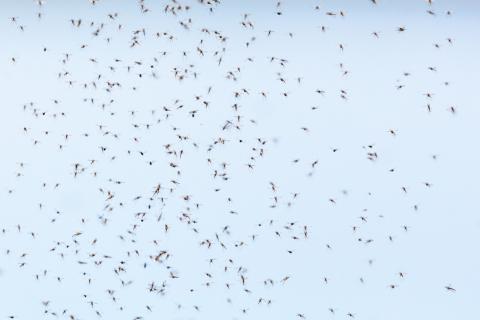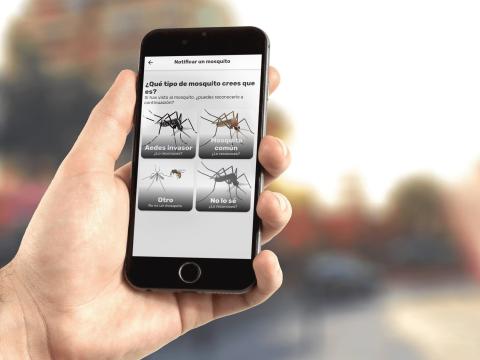Reactions to an analysis of the causes of insect decline in Europe
The decline of insects in Central and Western Europe in recent years is mainly due to human activities and the intensification of agriculture, according to a study funded by three companies (Bayer, BASF and Syngenta) that manufacture pesticides. The paper, published in PLoS ONE, summarises an analysis of 82 other published studies and explains the causes of population declines in two groups of insects: carabids (ground beetles) and lepidopterans (including moths and butterflies). The authors estimate that "anthropogenic activities in general" are most responsible for this decline, followed by agricultural intensification (including pesticides) and climate change in third place.

Jorge Lobo declive insectos EN
Jorge M. Lobo
Researcher in the Department of Biogeography and Global Change at the National Museum of Natural Sciences (MNCN-CSIC)
This is not an experimental study or one that compares past and present data. It is a review of 82 published papers on two unique groups of insects (one of the many families of beetles and butterflies) in a very specific region (Central Europe), with the aim of synthesising the main causes given to explain the decline in the populations of these insects in agricultural landscapes. The quality of the work is determined by the quality of the studies they use and, in my opinion, their conclusions should be based on a more solid treatment of the data.
There are studies that compare long time series data across the globe. Although there are not many of them, due to the lack of a clear strategy for collecting information on the most hyperdiverse group on Earth, the trend of declining populations is evident. This review does not add much to this picture and is partial, covering only a couple of insect groups and a very specific region, and I believe that the treatment of the data can lead to wrong interpretations. This paper points out that time comparisons can give rise not only to negative population trends but also to positive trends, and also gives little relevance to chemical contamination as a relevant pressure. The action of such chemical agents has been aptly called 'silent death' because of the difficulty in determining the effects of these compounds.
Complex and costly environmental chemistry studies and laboratory analyses are necessary to detect these substances and to prove their lethality or morbidity. Moreover, without including other variables related to, for example, the age of the studies, their location or the natural conditions of the region, it is bold to comment that a quarter of the studies show positive effects.
Of course, there are important limitations. The date of the studies reviewed should have been taken into account, as well as the degree of disturbance or naturalness of the regional matrix in which each is located. The authors find that about a quarter of the studies detect positive population trends and it would be interesting to know whether the age of these studies affects the lack of detection of a decline. The location of each study should also be taken into account, as a study conducted in a locality surrounded by natural landscapes may not show a decline in insect populations due to the 'source' effect of regional populations.
The conclusions of this synthesis paper stress, as does the press release, that the decline in insect populations is related to 'human activities that influence insect habitat', also emphasising the complexity of the effects of the many causal factors that could help to understand this decline. Among the factors cited, little relevance is given to the increased use of agrochemicals in explaining the disappearance and decline of insect populations. The authors highlight 'anthropogenic activity' as the fundamental factor, an overly general concept that does not identify any specific cause. However, there is a wealth of evidence and studies that establish a direct causal relationship between the use of insecticides and herbicides and the decline of insects. How can the massive and indiscriminate use of products manufactured to kill insects and their populations not affect them?
What is needed are (i) public initiatives capable of providing reliable and standardised time series data, (ii) studies comparing the composition and diversity of insect communities sampled in the past and present, (iii) experimental data on the effects of the three main processes affecting insect populations (chemical pollution, habitat modifications and climate change) and their interactions.
Carrying out these studies and the production of results should not slow down the immediate implementation of conservation measures.
Declares not having any conflicts of interest - neither with the study’s authors, nor with the companies that fund their work.
Guy Pe'er - insectos EN
Guy Pe'er
Conservation biologist at the German Centre for Integrative Biodiversity Research (iDiv) and Helmholtz Centre for Environmental Research (UFZ) in Germany
As a review of published studies, the methods taken in this paper are quite straightforward. Based on 82 published scientific studies, the authors could confirm that anthropogenic pressures, particularly agriculture and urban expansion, are the key drivers of insect declines in western and central Europe – and demonstrate that the impacts are often indirect (e.g. by affecting habitats). The results are not new but they help affirming that, even if the picture is complex, quite a number of studies point in the same direction.
The authors mention a range of limitations. Some problems emerge from the heterogenous nature of the original papers, while others relate to the natural complexity of anthropogenic pressures. Namely, it is hard to differentiate one pressure from the other, and in fact, some of the original studies could not, or did not try to, identify the exact drivers. One thing that is quite unfortunate is that the authors did not deliver recommendations based on their outcomes, as to how the drivers and pressures could be address.
The authors made clear statements about the contribution of humans, particularly agriculture (including agrochemicals) to the observed results. This could show one or two things: either that also [the companies that funded the study] acknowledge the key contribution of agriculture to biodiversity loss, or that peer-review processes help ensure the quality of scientific papers, or both.
The paper highlights that we are exerting multiple pressures on natural ecosystems, indicating how urgent it is to halt and reverse as many of these pressures as possible. Currently the EU is negotiating the Nature Restoration Law, which the European Commission recently proposed, and it is under much political pressure to dilute it and, especially, to remove the parts in it that addresses nature restoration in agricultural areas. The clearest recommendation that arises from this paper is therefore to ensure that the Nature Restoration Law advances with all its components, as soon as possible. Addressing our pressures on nature is essential, both for insect survival and for the services they provide us all.
Francisca Ruano - insectos EN
Francisca Ruano Díaz
Professor of Zoology at the Department of Zoology and coordinator of the Applied Ecology and Agroecosystems research group at the University of Granada
The article addresses a complex problem, due to the large number of factors that control insect populations, which – let us remember – are important as an economic threat to certain human activities, but, above all, due to their decisive involvement in ecosystem services such as pollination. , the biological control of pests and diseases, and nutrient cycling, without forgetting that they are part of the food consumed by many other organisms. Its positive effect on our activities is much greater than the negative.
On the decline of insects and its implications for humanity, a lot of scientific literature has been produced so far, to such an extent that the objective proposed by the work in question (Introduction, line 11 "Guide relevant policies") has already been achieved. to effect in the European Union, approving the Biodiversity and Farm to Fork strategies, which propose a 50% reduction in the use of pesticides and the restoration of 20% of terrestrial ecosystems before 2030, to alleviate biodiversity problems related to climate change.
The authors obtain, however, as a fundamental conclusion that anthropogenic activities have a greater effect on the decline in the abundance of carabid and lepidopteran populations, while the use of pesticides has a lesser effect on the general decline of both. groups.
In the first place, the use of pesticides is an anthropogenic activity, so this last category should be defined more precisely or, better, changed by the different activities that compose it.
Secondly, it is hardly credible that the use of pesticides, including insecticides, has such a low level of effect on the populations of these organisms, especially butterflies that, throughout their cycle, are highly exposed to these applications. This fact may be due to the fact that herbicides and/or fungicides are also included in the pesticide category, with a much lower direct effect on insects.
For all these reasons, as indicated by some related articles in the bibliography of the article: it is obvious that more detailed studies are needed on the different variables that control the survival of insects in general, at different scales, with different taxa and geographical locations (Dornelas and Daskalova 2020), but without ceasing to act on the most well-known and direct factors that influence insect populations (Forister et al. 2019) and that are already included in European legislation: the maintenance of natural habitats where insects can perpetuate themselves. (EU Nature Restoration Law) and the reduction of insecticides released into the environment (Biodiversity and Table for Fork strategies of the EU).
Francisco Sánchez-Bayo - insectos EN
Francisco Sánchez-Bayo
Honorary Associate Professor, School of Environmental and Life Sciences, University of Sydney, Australia
The study is well done and the data obtained from the literature is analysed using an appropriate method - although, in my opinion, a bit complicated. The distinction between causes, pressures, states, impacts and responses does not help to fully understand the global analysis, which, ultimately, could be summed up in two terms: causes and impacts. Alluvial graphs, on the other hand, are a good way to represent the results.
The study is based on our first paper on insect decline and follows the same structure and methodology: a compilation of studies in the scientific literature on insects and analysis of possible causes based on what the authors of the original studies reported.
The biggest novelty is that the authors also analyse population increases of some of these species (we only analysed declines). Those increases are due to habitat improvement in areas with extensive agriculture (as opposed to intensive agriculture that uses fertilisers and pesticides) or conservation zones, and, in other cases, climate change.
The conclusions are otherwise the same as ours: the overall decline for carabids and lepidoptera is estimated at 39% and 48% respectively, with the declines far exceeding the increases for some of those species (24% carabids and 26 % lepidoptera). Ditto for the causes of declines, which are largely due to habitat modification by human activities, agricultural intensification (inevitably involving the use of fertilizers and pesticides), and to climate change.
[We must take into account] the same limitations that we had when doing our study: the causes analysed are those that the authors of the original studies report in their articles and, in most cases, are presumed, not confirmed.
I am surprised that the authors do not cite any of the articles on the subject published two years ago in a special issue of the Proceedings of the National Academy of Sciences of the United States. They also do not cite our latest review on the subject, published in 2021.
It is not clear why these companies [Bayer, BASF and Syngenta] have funded this study. The curious thing is that the authors reach the same conclusions as us, although they avoid blaming pesticides. Instead, they blame intensive agriculture as the second major cause of declines (the first cause [they cite] is anthropogenic activities in general), although they admit in the text that such agriculture is closely linked to the use of fertilisers and pesticides. That is why we point to fertilisers and pesticides as the second cause of insect decline, since they are an integral part of this type of agriculture and impact insect populations both directly (by killing insects) and indirectly, through changes in animal communities and even habitat (through herbicides) in agricultural areas.
The decline of insects is a reality confirmed by most of the studies that exist on the subject, and the increases in some insect species are due to human interventions aimed at restoring affected ecosystems, or to climate change that favours some species.
To remedy the situation, we need to change from the current intensive agricultural system to another system that is compatible with the biodiversity of insects and other organisms. That is what many researchers—myself included—have repeatedly indicated.
Empresas Bayer, BASF, Syngenta
Quintana Rumohr et al.
- Review
- Peer reviewed



